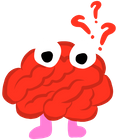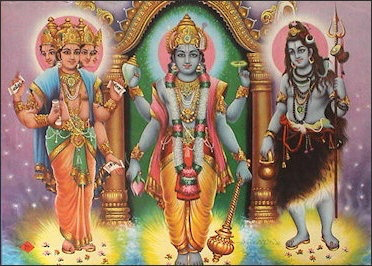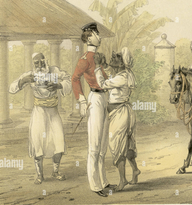Hinduism is the world’s oldest religion and the third largest followed religion in the world. Yet despite its numbers, vast history, and global influence I often found whilst growing up in the West as a Hindu, that most people didn’t know what it was, though it was a dead religion, or were taught incorrect things about it.
The first time I realized this was in 8th grade history class; we were learning about the world’s religions and to my excitement, Hinduism was today’s topic of learning. But I was devastated as I read in the textbook in front of me that Hinduism was a religion that existed thousands of years ago that no one followed anymore.
The writer referred to us as barbarians who worshipped cows and millions of different gods performed animal sacrifices and lived in a society that believed in inherent inequality through the caste system and the disregard of women. This was all wrong, every bit of it, so I raised my hand and told the teacher. She simply said, well that’s what the textbook says and the textbook is never wrong. But it was.
That day a group of girls made fun of me for speaking out in class and for being a barbaric Hindu. The irony of it is, I still follow those girls on social media, and I regularly see them posting about doing yoga, manifesting, meditating to open their chakras, and how karma is going to get back at their “haters”. It’s outrageous that in western society it’s become normalized to appropriate Hindu ideologies and culture (oftentimes incorrectly) but at the same time diminish its people and it as a religion.
However, most people I’ve met want to know more about it, but don’t know where to start. This is why I’ve decided to do a series to help people better understand Hinduism, clarify some common misconceptions, and understand the difference between cultural appreciation vs. appropriation. The first part of this is simply understanding Hinduism’s basics, so below are some common questions about Hinduism and their answers. Please do note that many of the answers are much more complex than could be fit into this article but the answers do cover the basics.

1) How did it start? Who is the founder?
Hinduism doesn’t have a single founder and its origin goes back to before recorded history. In fact, Hinduism wasn’t originally an organized religion but simply a way of life. This is why there is a lot of flexibility in Hinduism compared to other religions. The term itself was only dubbed recently, around the 1800s, to refer to the collection of different ideologies that share similarities found in South Asia. Before that, the term Hindu existed as a geographic term to refer to those that lived in the Indus River Valley. Many Hindus believe that the faith existed before the creation of time itself and has always existed.
2) How many gods does Hinduism have?
Despite common belief, most Hindus only believe in one Supreme God who is the true nature of reality and the empirical cosmic truth. You’re probably thinking, wait doesn’t Hinduism have millions of gods and goddesses?
This is a common misunderstanding. According to Hindu texts, God is omnipresent, omniscient, all-knowing, and infinite not bound by the laws of physics. God is found in living and nonliving things because the universe and all its beings are one. With this belief, God is present in every person and animal you meet, as well as things like the wind and the sun. This allows Hindus to select their own personal gods to worship that act as deities, or a simpler representation of the Supreme god. There is the main trinity of deities consisting of Brahma (the creator), Vishnu (the preserver or maintainer), and Shiva (the destroyer). There are also several other deities of gods and goddesses that Hindu’s worship. Other than these deities Hindus believe in avatars of deities like Vishnu, who reincarnate into this world whenever it is overcome by evil. Below is a really helpful infographic I found:

3) Do Hindus have a main text like the Bible?
Hindus have a lot of different texts, not just one. There are the four Vedas, Mahabharata, Bhagavad Gita, Puranas, Ramayana, Upanishads, Yoga Sutra of Patanjali, and more. The Vedas are the most ancient religious text in Hinduism and are believed to have been passed down directly by God himself. The four Vedas are the Rigveda, the Samaveda, the Yajurveda, and the Atharvaveda each with different subjects talked about.
4) Do Hindus worship cows?
Hindus do not worship cows. But they do respect all living beings and many Hindus especially respect the cow for its generosity and how even though it takes little, it selflessly helps sustain human life.
5) What do Hindus think is the purpose of life?
To Hindus, there are four parts to the purpose of life. Below is a concise explanation of these:
Dharma: To be righteous, virtuous, and live ethically. To do one’s duty.
Artha: To pursue wealth and prosperity (while pursuing dharma).
Kama: To obtain enjoyment in life.
Moksha: Many Hindus believe that this world is a Maya or an illusion. The ultimate goal is to attain enlightenment and become one with God. To do this you must overcome Maya. There are four paths to attain moksha: jnana yoga, raja yoga, karma yoga, and bhakti-yoga.
6) What does yoga mean in Hinduism?
In Hinduism yoga is a way to attain self-realization and become one with God, or moksha. Yoga is a way to realize one’s true self and connect the body, breath, mind, subconscious, consciousness, and soul. Yoga means uniting with the self. Most of the yoga practised in the west is actually not even yoga but just asana. Asana is the physical part of yoga, the stretches. In no way are the words yoga and asana interchangeable, and using them as such is cultural appropriation. True yoga itself is more of a lifestyle, with its most common form having 8 stages. The stages are listed below in another very helpful infographic I found:

7) What does namaste mean for Hindus?
Namaste is a Hindu greeting used in both scenarios of saying hello and goodbye but means much more than that. In Sanskrit, namaste directly translates to “the divine in me bows to the divine in you”, referring to the Hindu belief that God is found in everyone. When Hindus say namaste they usually press their palms together and bow down. In India, namaste is many times used informally.
8) What is karma?
In Sanskrit, karma directly translates to action. In simple terms, it is the belief in Hinduism that if you do good things, good things will happen to you and that if you do bad things, bad things will occur. Karma doesn’t just have to do with action but also the intention behind it.
9) Do Hindus believe in reincarnation or heaven?
Hindus believe in both. Hindus believe in reincarnation or samsara, believing where and when you are born is decided by the laws of karma, with karma following you in each life. In Hinduism, the soul or atman is eternal, and the body is simply a vessel. The soul begins in more primitive life forms, like unicellular organisms going onto more complex life.
Human life takes a lot of time to attain and is a privilege as they are the only beings capable of consciously doing good or evil. The ultimate goal is to break this cycle and achieve moksha, becoming one with God and the universe. In this cycle, Hindus believe that time is not linear and you can be reborn at any time.
Some Hindus even believe that all of the beings in this universe might just be reincarnations of one soul at different points in its spiritual journey and that a universe exists for each soul(This theory I personally find really cool because it means everyone you meet is just you at a different point and might support the multiverse idea!).
Hindus also believe in heaven in hell, but not in the Christian sense. According to the Hindu texts, the Puranas, there are fourteen worlds in the universe, seven upper (comparable to heaven) and seven lower (comparable to hell), bound in different times and space. After death, depending on karma, souls spend time in one of the worlds and then reincarnate depending on their desires, and of course karma.
10) What do Hindus think about other religions?
We respect other religions just as much as we respect ours. We even respect people who don’t believe in God. In fact, there’s a whole sector of Hindus who don’t believe in God but simply spirituality and that the Universe is energy. One of my favourite Hindu proverbs is, “There are hundreds of paths up the mountain, all leading in the same direction, so it doesn’t matter which path you take. The only one wasting time is the one who runs around and around the mountain, telling everyone that his or her path is wrong.” This is why most Hindus don’t go out of their way to try to convert people and many actually go to other places of worship regularly like churches (where Christians worship) or gurudwara (where Sikhs worship). I personally love going to different religious places to learn more about people’s ways of life.
11) Does Hinduism support the caste system?
If you’ve ever learned about Hinduism, the caste system has probably come up and been taught to you as a central part of Hindu beliefs. This is incorrect. The caste system as we know it today is not intrinsic to Hindu ideologies and the discrimination within it goes fundamentally against Hindu texts which repeatedly state that God is within every being and that every job should be equally respected, that of a king or that of a cleaner. The caste system and its relationship to Hinduism have been vastly misunderstood by the West.
In the modern-day, the caste system exists as a hierarchical social system where society is divided by occupation, or into castes, and one is born into their job with no social mobility. However, this was not the original system that came from Hinduism. The original system was the Varna system coming from the holy text the Bhagavad Gita and the Manusmirti, giving four main varnas in society that come from the different body parts of a Hindu deity Brahma: Brahmin (priests, professors, advisors), Kshatriya (politicians, warriors), Vaishyas (business people, merchants), and Sudras (labourers, service providers). This division was started to explain the concept of moksha, if one does their varna or job selflessly, they would gain closer to enlightenment. But over time those who had power began selfishly wanting to keep a hold of it through generations. Society then developed into a form of the more oppressive caste system, mostly under the rule of the Mongol and British invaders, with no social mobility and discrimination towards many castes.
12) Why do Hindus use the swastika? Are they Nazis?
Yep, this is an actual question I’ve been asked. No Hinduism has no relation to nazis. Hindus do use the symbol of the swastika, which is slightly different from the Nazi symbol. In Sanskrit, swastika means well-being and is a symbol that existed in many cultures for thousands of years before Hitler. It is an important Hindu symbol that means prosperity and brings good wishes. The four limbs represent the four Vedas, the four goals of life, the four seasons, the four directions, amongst other things. The symbol was culturally appropriated by the Nazis. Many Hindus today place the symbol in front of their houses, businesses, and draw the symbol during festivals for auspiciousness.

13) Why do Hindus say "Ummm" when they meditate?
We don’t say Ummm but Om, one of the most sacred sounds and spiritual symbols in Hinduism. During meditation and prayer, Hindus often say mantras, or different holy sounds and words. Om is one of them, being the literal vibration of the universe and the sound of the supreme God, connecting all things. It consists of the sounds:
"Ahh" which vibrates in your throat,
"Uhh" which vibrates in your stomach, and,
"Mmm" which vibrates in your head.
In many movies and TV shows, I’ve often seen stereotypical Indian characters chanting Ummm instead of Om, which probably perpetuated this myth and I personally find disrespectful. Below is the Om symbol:

14) Why do Hindus wear red dots on their heads?
The red dot you’re referring to is called the bindi or tilak (known by many other names throughout India) and doesn’t always have to be red. Hindus wear this to protect an important body chakra. Chakras are areas in the human body where concentrated energy lies.
There are 7 main chakras, and the Ajna chakra, the 6th chakra is where you put the bindi. The Ajna chakra is responsible for perception and intellect and by wearing bindi Hindus enhance the power of this chakra. Wearing the bindi is also believed to ward off negative energy coming from those with not-so-good intentions, as when you look at someone you look not into their eyes but at their forehead area where the Ajna chakra is located. Ancient Hindus and Hindus today (oftentimes during festivals and when they go to the temple) apply a red bindi with the powder kumkum. Modern Hindus also use the bindi as beauty accessories with them coming in all shapes, colours, and sizes in a sticker form.

15) Are Hindus not allowed to eat meat?
Hindus are allowed to eat meat but many choose not to for several reasons. The first is that Hinduism believes in the divinity of all creatures and nonviolence. Second, Hindus believe that every being has its own energy and that the purest form of energy comes from plants. Third, Hinduism believes that not eating meat reduces our impact on the Earth.















